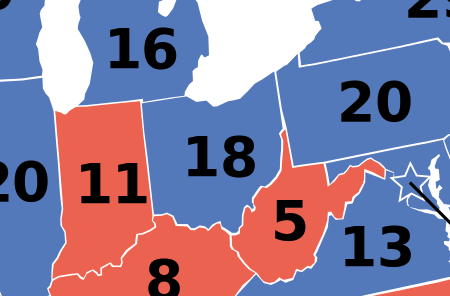How Obama Won Ohio

Credit: Wikimedia Commons
In retrospect, the single most important fact of the 2012 presidential campaign was that Barack Obama led steadily in Ohio from the late spring (when the Republicans settled on Mitt Romney as their nominee) through Election Day. Only in the aftermath of his strong performance in the first presidential debate did Romney briefly surge into a tie with Obama in Ohio, but even that situation quickly proved ephemeral, as Obama soon regained his narrow lead there. In view of the fact that Ohio generally leans Republican, and especially so in close presidential races like this one, Obama’s narrow but consistent lead in the Buckeye State during 2012 appears all the more remarkable -- and ultimately decisive.
How and why did Obama achieve such unusual strength for a Democratic presidential candidate in Ohio? First, the economy improved more there than in the country as a whole, thanks mostly to the auto industry and related sectors. Unemployment in Ohio from the spring onward was significantly below the national average, which strengthened Obama’s argument that things were getting better, economically speaking, on his watch. There was also a symbolic aspect to this achievement. The auto industry and its related businesses in Ohio are heavily populated by workers from lower-middle-class families without much higher education. Obama appears to have significantly increased his support from families like that in Ohio, and white lower middle class families especially, from 2008 to 2012. In effect, the fact that the pillar of economic recovery was in basic manufacturing helped Obama and the Democrats in Ohio make the broader argument that their policies are beginning to rebuild the economic foundations of lower-middle-class life. Obama and his people promised a kind of new New Deal four years ago; in Ohio it has gradually begun to emerge, and that proved crucial for his reelection prospects there.
At least as important, however, was the Obama campaign’s extraordinarily effective organization in Ohio, which targeted the key voting blocs and worked relentlessly to get them out in sufficient numbers. Perhaps the most striking thing about Obama’s victory in Ohio and nationally is that while the overall popular vote was close, Obama won most of the truly contested states; his organization turned out the votes in sufficient numbers where they were needed most. There was nothing accidental about that. In Ohio, a key reason for it had to do with one of the less-studied consequences of the U. S. Supreme Court’s decision in the Citizens United case. By striking down a provision of the anti-union Taft-Hartley Act of 1947, Citizens United freed union political operatives to target non-members directly for political purposes for the first time since the 1946 election cycle. In Ohio, organized labor remains a major factor in the state’s politics, and so much of Obama’s organization there consisted of union members targeting non-union members who seemed likely to vote for the president. Labor, working somewhat under the radar, flexed its muscles in Ohio and other states; and achieved something it is very good at doing, which is deploying its people power to produce specific amount of needed electoral turnout in key places. In that sense, Obama’s victory in Ohio and nationally also had a new New Deal quality, because Roosevelt and Truman built their electoral success on just that kind of voter mobilization by labor union model.
Only in the races for the U.S. House of Representatives did that approach not work well for the Democrats in Ohio, or nationally. GOP dominance of the redistricting process in Ohio and elsewhere during 2011-12 is responsible for that split picture. With so many congressional districts drawn to maximize Republican representation in Ohio and nationally, substantially altering the House proved beyond the Democrats’ reach. And so the Ohio House delegation, like the larger House of Representatives, will remain firmly in GOP hands, even though Obama and the Democrats generally had as good a night as they could have expected in Ohio and across the nation. Such is the new electoral pattern that seems to be emerging in Ohio and the United States more generally.
Related Links

